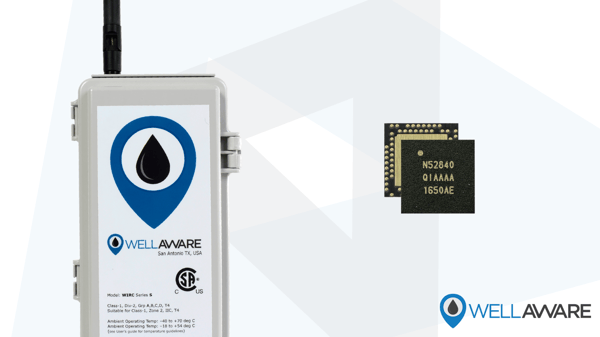
News, Insights, and more on Industrial IoT
This blog was co-authored by David Figoli, WellAware's Chief Technology Officer,

Over the next eight years, the Industrial Internet of Things (IIoT) is projected to explode.
According to Quince Market Insights, the IIoT market will grow at a 21% CAGR between 2020 and 2028, driven by advances in manufacturing technology, Industry 4.0, and the proliferation of IoT devices. The challenge now lies in using the IIoT to its fullest potential to drive next-gen business models.
To do that, we need ARM architecture to help us manage and deploy end devices in the best manner possible. In this post, we explain what ARM architecture is and highlight the top three reasons why industrial organizations should choose it for their IIoT hardware.
In technical terms, “ARM” stands for “Advanced RISC Machine.” It is a type of RISC (“Reduced Instruction Set Computer”) architecture that is becoming increasingly relevant in the modern world.
Compared to CISC (“Complex Instruction Set Computer”) architecture, RISC architecture is often quicker and far more simple. While CISC architecture (which includes the well-known x86 architecture) gets a lot of credit for its power and flexibility, RISC architecture plays a key role in Industry 4.0 where efficient data collection, processing, and transmission at scale is paramount.
RISC architecture requires fewer transistors, making it less costly and less power-intensive. It also runs on a leaner instruction set and codebase, which speeds up processing without creating excess heat. Furthermore, RISC architecture forms the foundation of ARM, initially developed by Acorn Computing in the late 1980s (note: ARM can also stand for “Acorn RISC Machine”).
Today, ARM architecture is developed and licensed by Arm Holdings, Inc. Arm has an interesting business model. Unlike processor companies, Arm doesn’t actually manufacture any physical processors.
Why not?
Arm takes a unique approach. Instead of manufacturing specific chipsets using the ARM architecture, they hold the intellectual property and license the core ARM architecture.
This has created a huge market for developers to utilize ARM architecture to build highly specialized systems. Many of the most prominent players in the tech sector license ARM architecture today, including:
 ARM technology is used by a veritable "who’s who" of consumer and industrial IoT developers.
ARM technology is used by a veritable "who’s who" of consumer and industrial IoT developers.
Because it means that IIoT developers have the flexibility to create what they need for their organization’s specific IIoT applications. If an IoT developer chooses a processor from say, Intel, they are constrained to building non-integrated peripherals around a predefined chipset.
But with the ARM architecture license in hand, IIoT engineers can develop unique Systems-on-Chip (SoC) and Systems-on-Modules (SoM) that aren’t limited to any single Central Processing Unit (CPU). Instead, they can directly build end products around whichever processors and peripherals they choose using ARM architectures.
At a time when agility and customization are critical, such a model can break down many of the barriers to IIoT transformation. ARM’s widespread adoption alludes to its effectiveness and value for major IoT undertakings.
With this in mind, let’s dive into the meat of this blog: why choose ARM for the industrial IoT?
As validated by the many major IoT device manufacturers who license it, ARM architecture is a boon for the industrial Internet of Things. While there are many reasons to choose ARM, three stand out as it relates to IIoT device development:
In industrial environments, power can be a precious resource. Consider remote oil wells in the middle of the Gulf of Mexico (the Perdido oil platform is ~200 miles south of Freeport, TX!).
Getting power - and maintaining its supply - to such remote infrastructure can be tremendously costly. In order for IIoT networks to be financially feasible, devices must be able to function without relying on spotty or absent power infrastructure. Our IIoT devices need to sense, digitize, and send large volumes of data without draining finite energy resources.
Achieving such an end state gets harder when we introduce wireless IIoT devices to the picture, as wireless networking is generally power-intensive. Although some low-power networks can mitigate this problem, they typically have to sacrifice throughput to do so.
When it comes to IIoT deployments, industrial organizations can’t afford to make such a trade-off. Devices must be able to maintain throughput and wireless connectivity while staying online for extended periods. They need to conserve as much power as possible to send data where it needs to go at any given time. And if processors eat up too much of the power budget, that leaves less for data transmission.

In certain settings, we need IIoT devices to run without external power. For example, what if you wanted to monitor an actual power source e.g., a generator? Your end device couldn’t use that generator for its power and also monitor its performance or uptime. How would you observe a remote pipeline where there is no existing power infrastructure?
Obviously, it wouldn’t make sense to install a local power grid for the sole purpose of asset monitoring. Renewable energy harvesting certainly has a place here, but cost can still be prohibitive and effectiveness may be limited.
Without power-efficient IIoT devices, effectively monitoring these assets just wouldn’t be feasible.
ARM architecture allows us to run IIoT devices on independent power sources. Consider the modern smartphone (which are really just consumer IoT devices). Smartphone utilized ARM architecture to preserve processing power to maximize wireless transmission and screen time.
Most smartphones will last about a day or two under normal usage conditions, in large part because streaming internet connectivity and LCD screens need lots of power. For IIoT devices, however, a few days of battery life doesn’t fit the bill.
We need IIoT devices to last much longer. For instance, the WellAware CONNECT device, which uses 4G LTE cellular technology, can survive several years on just three D-cell lithium batteries. This is what makes ARM so attractive for IIoT devices in remote environments with limited or unstable power. When we limit data transmissions, we can rely on ARM processors to use minimal power, preserving it for greater use.
Because ARM is a licensed architecture and not a chip that needs to be integrated, there is a vast world of development possibilities.
If you’re a maker nerd, you’ve likely heard of Arduino or Raspberry Pi. Both technologies represent highly flexible ARM-based microcontrollers that empower users to easily control sensors and peripherals.

The WellAware CONNECT IIoT device uses a Nordic SoC built on ARM architecture
In a similar way, developers can use ARM to manage IIoT sensor inputs, process different types of data, and actuate various devices or outputs. ARM gives IIoT device developers access to integrated components and peripherals straight off the shelf.
For example, the Nordic nRF52840 SoC that powers the latest generation of WellAware CONNECT devices has:
With ARM, all of these capabilities and components are integrated into a single SoC, allowing WellAware developers to get exceptional results from end devices with a lot less work.
The way in which the ARM licensure platform is designed enables it to support so many different technologies, from smartphones and laptops to servers and IoT devices. On the industrial IoT front, we can use ARM to get highly specialized sensor data collection, output actuation, and wireless data transmission all in a single chip!
Our development team leans on ARM to rapidly develop new hardware solutions for unique industrial problems. Already, we’ve built numerous flavors of industrial I/O around common ARM architecture, from chemical pump controllers to tank level monitors to smart air purification systems. On top of that, our code is efficient and standardized because we can access all systems on a single SoC.
ARM makes all of this possible.
Lastly, and perhaps most importantly, is the community. ARM architecture development is supported by an active, robust global development community. For many, this is the single-most attractive feature to ARM architecture and the integrated chipsets it enables.
ARM is the most widely used Instruction Set Architecture in the world, with over 130 billion ARM processors produced as of 2019.
Because ARM is so popular, it is deeply understood and supported. In the same way that we get integrated physical components through SoCs, we also have thousands, if not millions, of libraries available at our disposal that make IIoT development that much easier.

Rather than build entirely new functions, developers can draw on the past work and expertise of others to obtain pre-built software features. We don’t have to write our own Modbus commands, define WiFi packet structures, implement MQTT protocols, or program new ML models from scratch. These capabilities and more already exist in libraries that some of the world’s brightest developers contribute to regularly.
In fact, Linaro, an ARM development community founded by many of the most notable ARM licensees, focuses on collaborating on non-differentiating libraries and solution sets. Developers can leverage Linaro to find solutions to common problems, which frees up their time to invest energy on innovation and differentiation. Because the IIoT is hard to master, this point is really important. ARM comes with an engaged community that makes problems easier and faster to solve.
The IIoT isn’t going anywhere any time soon. For those who want to take advantage of real-time monitoring and smart devices for industrial applications, ARM architecture is the best path forward to ensure long-term success.
To learn more about how WellAware uses ARM architecture to power our suite of monitoring solutions, or if you want to skip the development process and get right to generating and visualizing high quality IIoT data, contact us today.
Like what you're reading? Sign up for updates!
Have a Question?